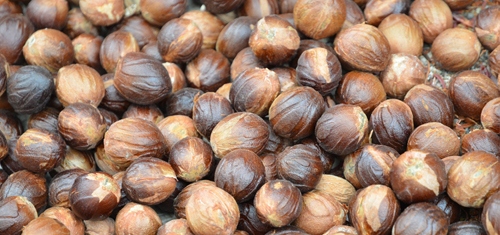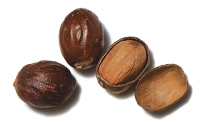Nutmeg
Nutmeg
Pronounced: nut-meg

The nutmeg tree is unique among spices as the donor of two distinct spices of commerce. Nutmeg is the seed of an apricot-like fruit of the nutmeg tree and mace is its aril a thin leathery tissue spread over the seed coat. Both spices are strongly aromatic, resinous and warm in taste. Mace is generally said to have a finer aroma than nutmeg. Nutmeg quickly loses its fragrance when ground. Commercial part of this tree spice is seed. Naturally, nutmeg is limited to the Banda Islands, a tiny archipelago in Eastern Indonesia (Moluccas).
What Is Nutmeg?
 The nutmeg tree is a large evergreen tree spice belonging to Myristicaceae family and grows to a height of about 18 m. It produces fruits eight to nine years after planting. The fruit of nutmeg tree, which is similar in colour and size to apricot, splits when ripe revealing the brilliant red arils encasing the brown nut. The red arils on drying become orange in colour and are the mace of commerce. The nut is also dried until the kernel inside rattles.
The nutmeg tree is a large evergreen tree spice belonging to Myristicaceae family and grows to a height of about 18 m. It produces fruits eight to nine years after planting. The fruit of nutmeg tree, which is similar in colour and size to apricot, splits when ripe revealing the brilliant red arils encasing the brown nut. The red arils on drying become orange in colour and are the mace of commerce. The nut is also dried until the kernel inside rattles.
Plant and Cultivation
Since the nutmeg trees require shade, suitable fast growing shade trees like Albizia, Erythrina etc. are planted in advance. Banana can also be grown as a shade crop in the early stages. Pits of 90 x 90 x 90 cm are dug at a spacing of 8 x 8m with the onset of southwest monsoon. The pits are filled with topsoil and compost or well-decomposed cattle manure and seedlings are planted.As nutmeg is cross-pollinated, considerable variations are observed in the crop. The seeds are extracted from the pericarp and sown immediately in sand beds of convenient length, 1 to 1.5 m width and 15 cm height. Regular watering is necessary for good germination. Germination may commence from about 30th day and last up to 90 days after sowing. About 20 days old sprouts are transplanted to polythene bags containing a mixture of soil, sand and cow dung.
Planting in the main field is done at the beginning of rainy season. Pits of 0.90 m x 0.90 m x 0.90 m size are dug at a spacing of 8 m x 8 m and filled with organic manure and soil about 15 days earlier to planting. For planting plagiotropic grafts, a spacing of 5 m x 5 m has to be adopted. A male plant has to be planted for every 20 female plants in the field. Nutmeg can best be grown as an intercrop in coconut gardens that are more than 15 years old where shade conditions are ideal. Coconut gardens along river beds and adjoining areas are best suited for nutmeg cultivation. Irrigation is essential during summer months. When fruits are fully ripe, the nuts split open. These are either plucked from the tree or allowed to drop. The two major products are nutmeg and mace. Dried nutmeg and mace are directly used as spice and also for the preparation of their derivatives.
Description
Nutmeg is one of the two spices – the other being mace – derived from several species of tree in the genus Myristica. The most important commercial species is Myristica fragrans, an evergreentree indigenous to the Banda Islands in the Moluccas (or Spice Islands) of Indonesia. Nutmeg is the seed of the tree, roughly egg-shaped and about 20 to 30 mm (0.8 to 1.2 in) long and 15 to 18 mm (0.6 to 0.7 in) wide, and weighing between 5 and 10 g (0.2 and 0.4 oz) dried, while mace is the dried “lacy” reddish covering or aril of the seed. The first harvest of nutmeg trees takes place 7–9 years after planting, and the trees reach full production after twenty years.
Producing Countries of Nutmeg
Naturally, nutmeg is limited to the Banda Islands, a tiny archi¬pelago in Eastern Indonesia (Moluccas). Main producing countries today are Indonesia (East Indian Nutmeg) and Grenada (West Indian Nutmeg). World production of nutmeg is estimated to average between 10,000 and 12,000 tonnes per year, with annual world demand estimated at 9,000 tonnes; production of mace is estimated at 1,500 to 2,000 tonnes. Indonesia and Grenada dominate production and exports of both products, with world market shares of 75% and 20%, respectively. Other producers include India, Malaysia, Papua New Guinea, Sri Lanka, and Caribbean islands, such as St. Vincent.
Consuming Countries of Nutmeg
Nutmegs are mainly exported to Europe and Asia, Grenada nutmeg mostly finds its way into the USA. The principal import markets are the European Community, the United States, Japan, and India. Singapore and the Netherlands are major re-exporters.
